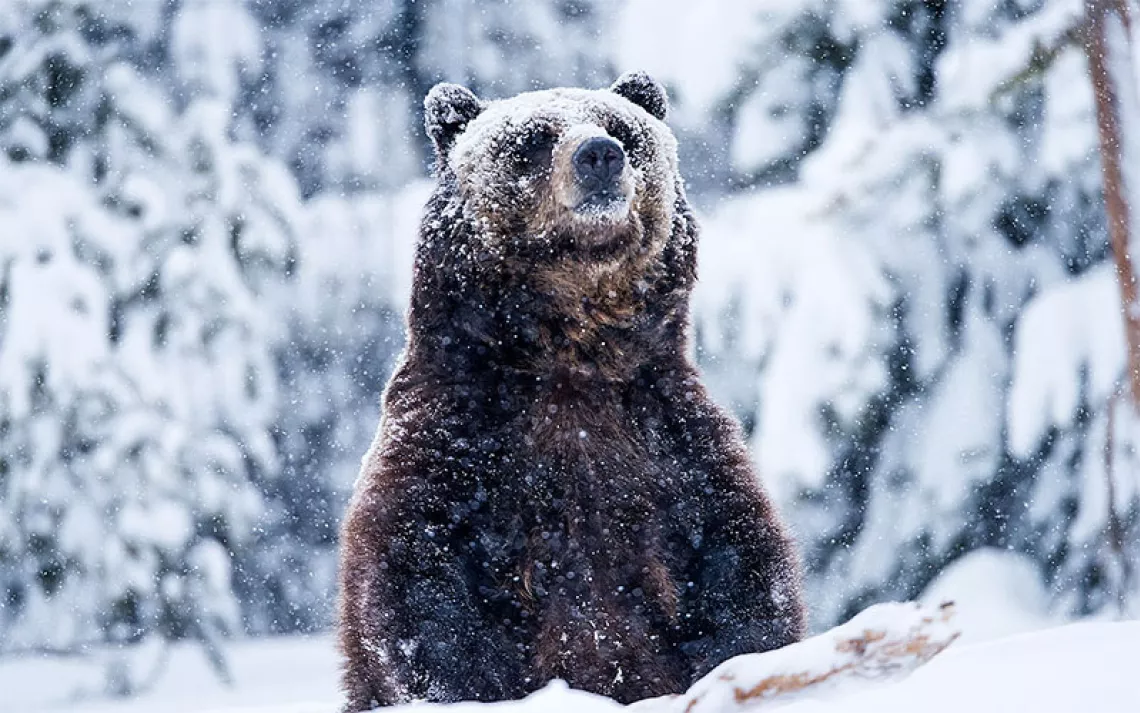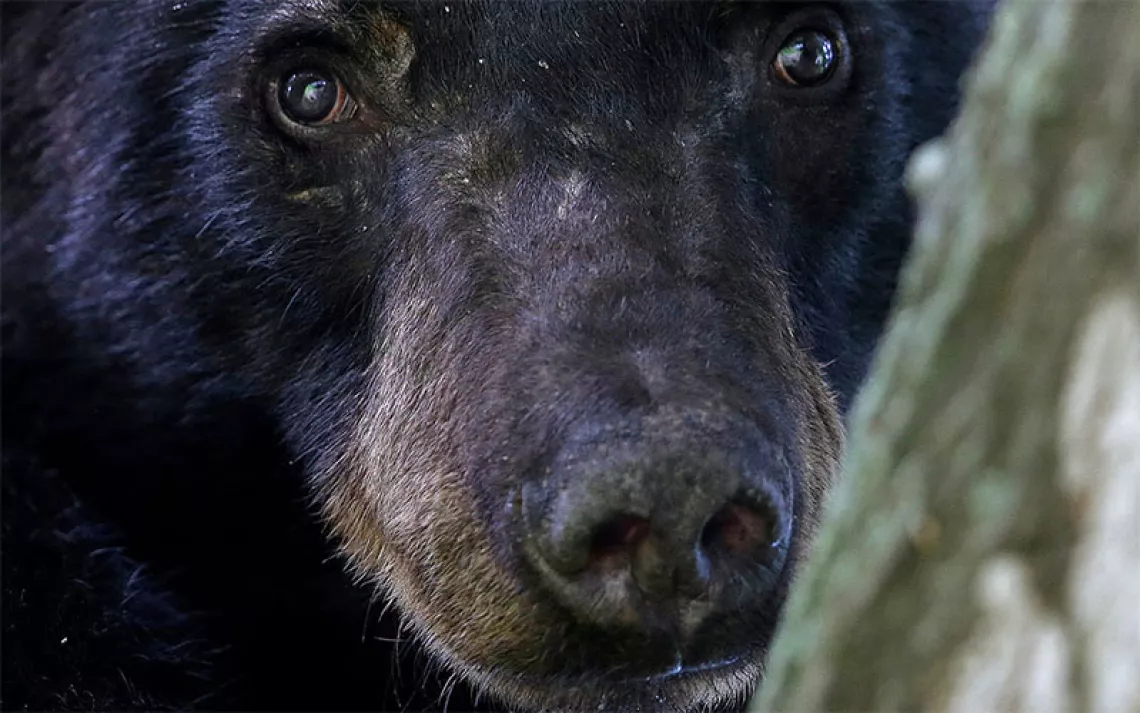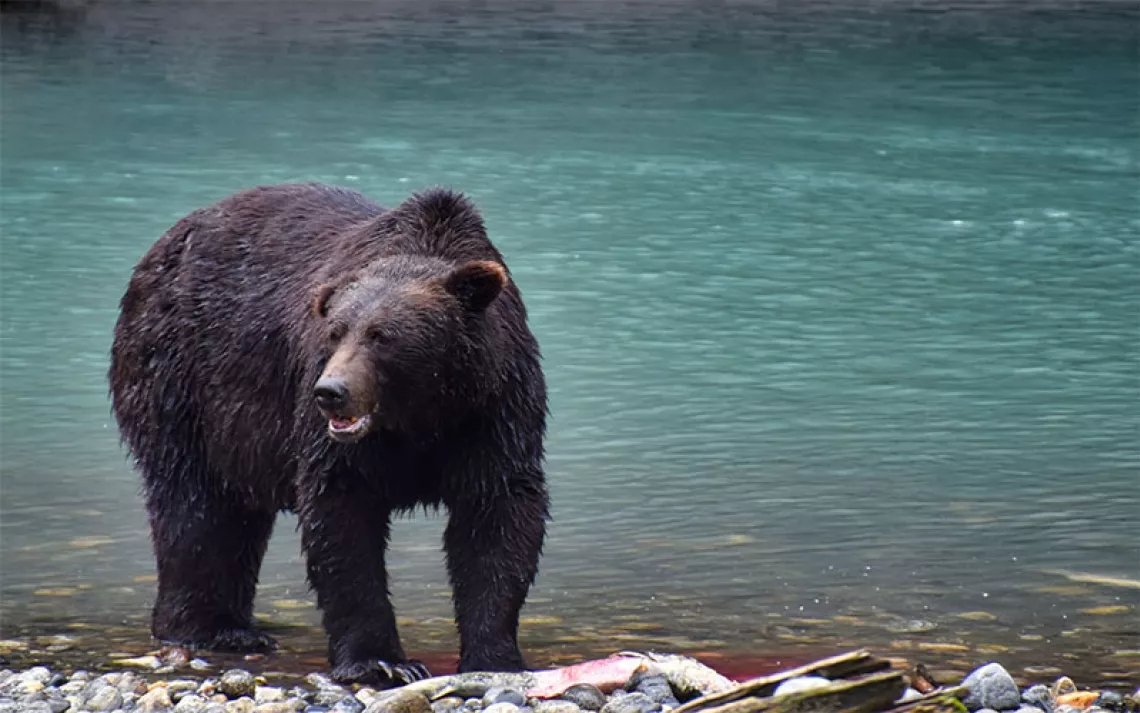New Roads in Tongass National Forest Could Harm Bears
The Trump administration is moving ahead with an ill-advised plan

Photo by wanderluster/iStock
My friend Teresa Whipple and I had come to Chichagof Island in Southeast Alaska’s vast Tongass National Forest looking for bears. A lot of tourists come to Alaska to see the wildlife, of course, but for me and Teresa, that’s our job. We have both spent nearly a decade working as bear guides for visitors, and we had traveled to Chichagof in early September to explore the different watersheds there to see about establishing a new bear-viewing area.
The ABC Islands—Admiralty, Baranof, and Chichagof—have exceptionally dense concentrations of rainforest grizzlies, also called brown bears. Chichagof alone likely has more grizzlies than in all the contiguous United States. It wasn’t at all surprising, then, that on our first night of our exploratory trek, we heard, as we lay in our tent, a grizzly chasing salmon through a nearby slough. The bear exhaled loudly—perhaps catching a whiff of our scent—and then the sound of its footsteps echoed away into the darkness.
That’s life as usual on Chichagof Island. But the bears’ lives—their ability to make a livelihood—may very well change if the Trump administration and Alaska’s retrograde political leadership succeed in rolling back long-standing protections for the Tongass National Forest.
Photo courtesy of Bjorn Dihle
At 26,500 square miles, the Tongass is North America’s equivalent of the Amazon. It encompasses the majority of Southeast Alaska and is the largest (relatively) intact temperate rainforest left in the world; by comparison, nearly 96 percent of the Pacific coast’s old-growth forests from California through Oregon and Washington have been logged. The Tongass’s sheer size makes it a globally significant carbon sink, and critical in combating climate change. In 2001—after receiving overwhelming public comment against more logging in the area— President Bill Clinton’s administration instituted the Roadless Rule, which protects inventoried roadless areas across America from unnecessary road building, old-growth logging, and other resource extraction. After decades of industrial logging in Southeast Alaska and the loss of around 50 percent of the region’s old growth, 14,800 square miles of the Tongass became protected.
Until now, that is.
A few days before Teresa and I began our trek, President Trump—with support from Alaska’s governor and congressional leaders—directed Agriculture Secretary Sonny Perdue to exempt the Tongass National Forest from the Roadless Rule. A month and a half later, in mid-October, the Forest Service released its first draft of the administration’s formal plan.
As I know from my experience in the Tongass, a revision of the Roadless Rule would be devastating for the bears, other wildlife, and many of the people who live here.
In 2015, I helped develop a viewing area in a watershed owned by an Alaska Native corporation; it had been logged in the 1970s. A stand of trees in the Tongass, once cut, takes up to 200 years before it again becomes ideal old-growth habitat. Until then, trees are the same height, choking out the understory and essentially creating a dead zone. The Alaska Native corporation wanted to figure out a way to make money off its land before another century or more passed, when the trees would become marketable again. The problem was that the majority of bears had long ago left the stream for watersheds that hadn’t been logged. The mission was a total bust—and a stark reminder that without intact habitat, both bears and people lose out.
The watersheds Teresa and I were exploring on Chichagof showed much more promise for the simple reason that they hadn’t been logged. Earlier that day, we watched as pink and chum salmon spawned, died, and gave their flesh back to the land and water. It had been an incredibly hot summer, and most of the bears were deep in the mountains taking advantage of a phenomenal berry crop. In the evening, several bears emerged from the shadows of ancient trees to prowl the beach and fish for salmon. We watched one large bear come out in the twilight as we sat on a rocky peninsula eating dinner.
Photos courtesy of Bjorn Dihle
Normally, there’s no place I’m happier than deep in the wilderness. On this trip, however, I felt unbalanced. I couldn’t stop wondering what this place would be like for my son and future generations if the Roadless Rule were to be overturned and widespread commercial logging resumed.
There’s a recycled insanity behind the drive to open the Tongass’s old-growth forest for the paper and pulp market. Our current political leaders in Washington, DC, appear to subscribe to the philosophy that Alaska is a natural resource colony—rather than a home for nearly 700,000 people and a dream destination for millions of people across the world. Logging in Southeast Alaska is heavily subsidized by our taxes; according to the US General Accountability Office, the Forest Service receives only pennies on the dollar for every timber sale in the Tongass.
A majority of residents of Southeast Alaska support keeping the Roadless Rule in place, according to one survey of public comments to the US Forest Service. That support is likely based on firsthand knowledge of the benefits of preserved ecosystems, as well as an understanding of the measly benefits from logging. Intact habitat supports commercial fishing and tourism, which make up the lion’s share of the region’s economy. The heavily subsidized timber industry, in contrast, amounts to less than 1 percent of Southeast Alaska’s economy and employs about as many people as a single Wal-Mart. In 2020, visitors to the Tongass—who come here to witness natural wonders—are expected to spend nearly $800 million in the region. No one comes here hoping to see clear cuts. Logging old-growth forest is the opposite of investing in the future of the Tongass.
The morning after we’d heard the bears snuffling near our campsite, Teresa and I broke camp and shouldered our backpacks as the sunrise lit up the ocean and mountains in pink and purple. We followed fresh bear tracks along the beach as Sitka blacktail deer watched us warily from the edge of the forest. We explored a salmon stream, taking note of bloody fish carcasses and wet paw prints on gravel. A bear was right beyond the bend in the dark forest, but we backed away in hopes we wouldn’t disturb it from its breakfast. The sun began to beat down mercilessly, and we watched as a number of bears moved across a meadow on their way to take advantage of shade inside the rainforest. While we walked up another small stream, a young bear exploded out of the grass behind us and sprinted for the safety of the forest.
Later that day, we reached Corner Bay and the last watershed we planned to explore on this trip. The area had been logged—much of Chichagof’s old growth had been cut before the Roadless Rule came into effect in 2001—and it looked nothing like the forests where we had spent the previous days. Mountains and valleys had been stripped of their deep stands of hemlock and spruce trees. In the place of the old growth stood clusters of young spruce and deciduous growth with little value to wildlife or people.
We pushed through the brush and entered a “leave strip,” an area of forest that the Forest Service had left intact as a buffer of habitat along a salmon stream. Lying in the autumn-wilted skunk cabbage, at the shadowy edge of the forest, was the headless carcass of a brown bear.
There was still decomposing meat on its bones, which was odd. The rainforest eats its dead rapidly; often when a bear is killed, whether by another bear or a person, its bones will be picked clean in a few days. My guess was that it had been killed by a poacher, as the bear-hunting season had been closed for months.
It’s only a dead bear, I told myself. But I couldn’t shake the feeling it was an omen for the future of the Tongass if America’s great rainforest loses the protection of the Roadless Rule.
 The Magazine of The Sierra Club
The Magazine of The Sierra Club



